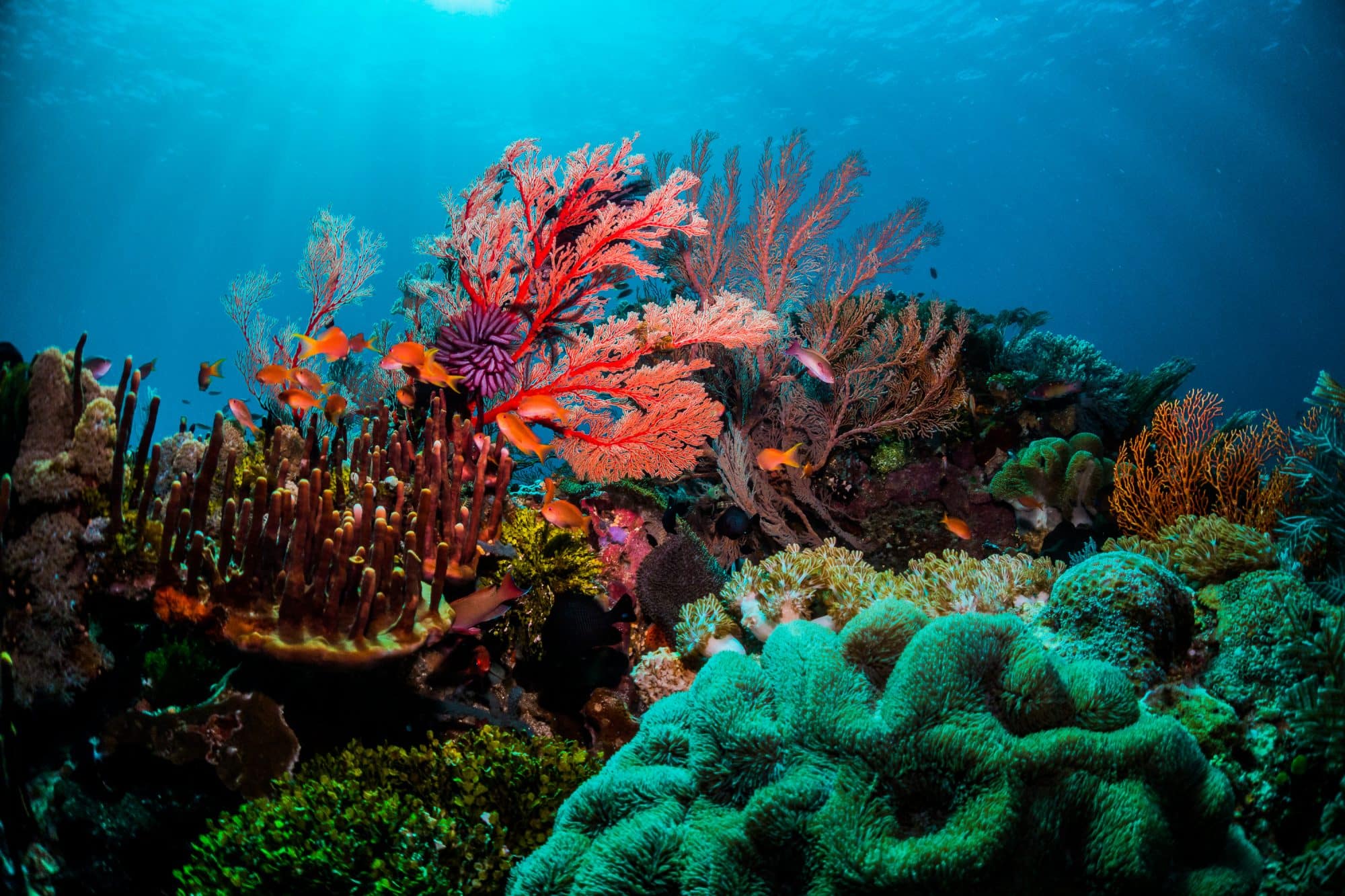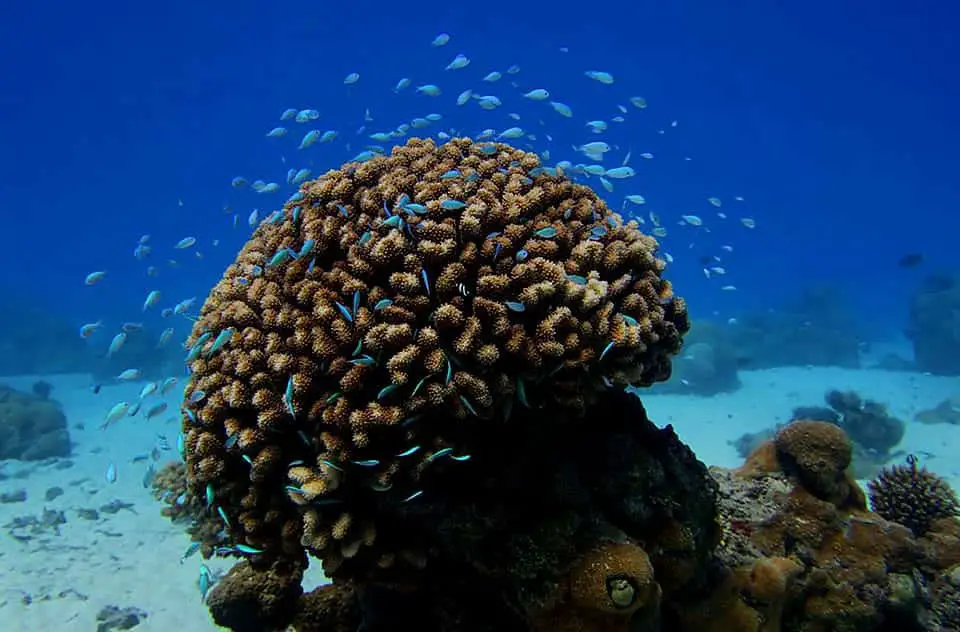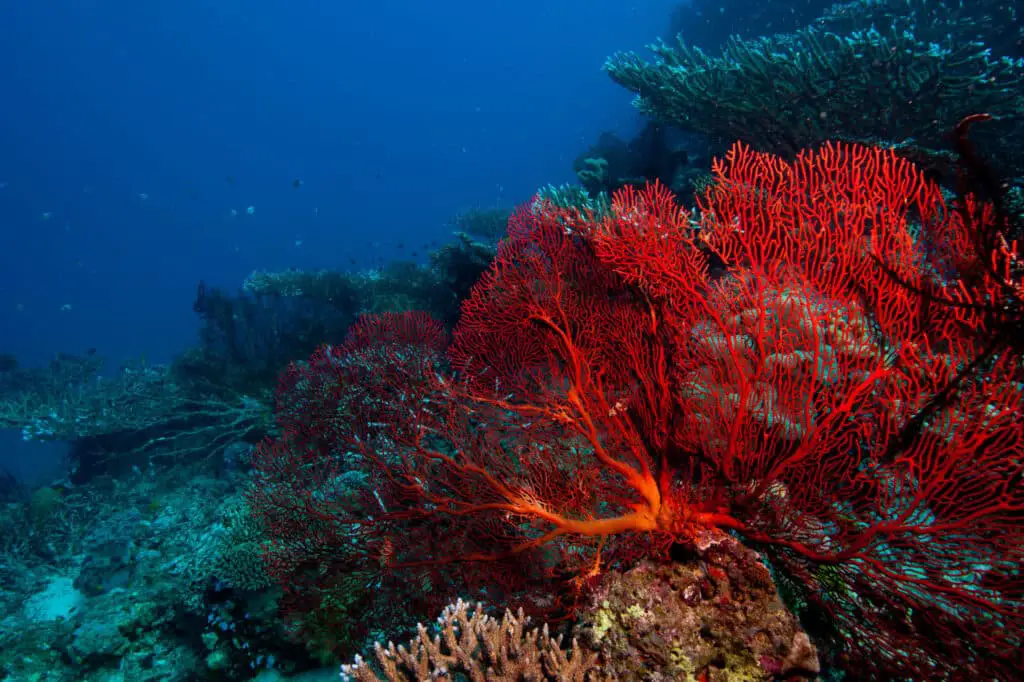What Does Coral Eat

Introduction
What Does Coral Eat: Coral reefs, often referred to as the rainforests of the sea, are incredibly diverse and productive marine ecosystems. While they may appear to be lifeless rock formations, corals are, in fact, living animals that rely on a variety of food sources to thrive. Understanding what coral animal eats is crucial to comprehending the intricate web of life within these vibrant underwater communities.
At first glance, coral polyps, the individual organisms that make up a coral colony, seem ill-equipped for capturing prey. They possess stinging tentacles called cnidocytes, which they use to immobilise and capture small organisms that drift by in the water. However, corals are primarily filter feeders, depending on a mix of phytoplankton and zooplankton, tiny organisms suspended in the water column, for their sustenance.
Coral reefs also benefit from a unique mutualistic relationship with photosynthetic algae called zooxanthellae. These algae reside within the coral’s tissues and harness sunlight to produce energy through photosynthesis. In return, the corals provide the algae with shelter and access to vital nutrients.
Intriguingly, some coral species can supplement their diet with larger prey, such as small fish and planktonic larvae, by extending their tentacles during nighttime hunting. This versatile feeding strategy enables them to adapt to changing environmental conditions.
Understanding what coral eats not only sheds light on their ecological importance but also underscores the fragility of these underwater ecosystems. As coral reefs face numerous threats, including climate change, pollution, and overfishing, preserving their delicate balance of life becomes imperative for the health of our oceans and the planet as a whole.

What is corals favorite food?
Almost all corals feed heavily on bacterioplankton. Other food sources include floating eggs, zooplankton (free-swimming microorganisms) and non-swimming organisms known as pseudoplankton.
Coral reefs, despite their seemingly stationary appearance, are bustling ecosystems with corals themselves being unique creatures with distinct feeding preferences. While it’s challenging to pinpoint a single “favorite” food for corals due to the diversity of species, they primarily rely on a diet of planktonic organisms and the photosynthetic products of symbiotic algae called zooxanthellae.
These particles mainly consist of phytoplankton (microscopic plant-like organisms) and zooplankton (small, drifting animal organisms). Corals extend their tentacles to catch these planktonic prey, immobilizing them with specialized stinging cells called cnidocytes, and then transferring them to their mouths for digestion.
However, the most significant dietary contribution for corals comes from their mutualistic relationship with zooxanthellae. These photosynthetic algae live within the coral’s tissues and use sunlight to produce energy through photosynthesis. In exchange, the corals provide shelter and nutrients to the zooxanthellae.
While corals don’t have personal preferences like humans, they thrive on a diet primarily consisting of planktonic organisms and the energy-rich products of their symbiotic algae partners. This dietary arrangement plays a crucial role in sustaining the remarkable biodiversity of coral reef ecosystems.
How do sea corals eat?
Corals are sessile , meaning they cannot move to get food. Instead, they stick out tentacles to catch prey items like zooplankton (animal-like organisms that live in aquatic environments) and other food particles. The prey is dependent on the size of the coral polyp.
Sea corals are fascinating creatures with unique feeding mechanisms that contribute to the health and diversity of coral reef ecosystems. Their feeding process primarily involves capturing and consuming small organisms from the surrounding water, aided by specialized structures and symbiotic relationships.
- Tentacles and Cnidocytes: Most corals have numerous tentacles armed with specialized stinging cells called cnidocytes. These tentacles are extended into the water, waiting to capture passing prey.
- Mucus and Cilia: Corals also secrete mucus, which covers their tentacles and aids in trapping prey. The mucus contains tiny hair-like structures called cilia that move in coordinated waves, directing captured particles towards the coral’s central mouth or gastrovascular cavity.
- Digestion: Once captured, the immobilized prey is transported to the central mouth.
- Symbiotic Algae: Many coral species have a mutualistic relationship with photosynthetic algae called zooxanthellae. These algae live within the coral’s tissues and provide a significant portion of the coral’s nutritional needs through photosynthesis.
- Nighttime Hunting: Some corals exhibit unique feeding behavior, extending their tentacles at night to capture larger prey like small fish or zooplankton.
Sea corals employ a combination of passive and active feeding strategies to capture and consume a variety of small organisms, while their partnership with zooxanthellae provides them with a consistent source of energy. This intricate feeding process contributes to the vitality of coral reefs, making them some of the most biodiverse and productive ecosystems on Earth.
What keeps coral alive?
Most reef-building corals also require very saline (salty) water ranging from 32 to 42 parts per thousand. The water must also be clear so that a maximum amount of light penetrates it. This is because most reef-building corals contain photosynthetic algae, called zooxanthellae, which live in their tissues.
The survival of coral, the foundation of vibrant coral reef ecosystems, depends on several critical factors that collectively contribute to their well-being and longevity.
- Symbiotic Relationships: One of the key factors that keep coral alive is their mutualistic relationship with photosynthetic algae called zooxanthellae. These algae live within the coral’s tissues and harness sunlight to produce energy through photosynthesis.
- Adequate Nutrition: Corals are not solely reliant on zooxanthellae. They also capture and consume small planktonic organisms, such as phytoplankton and zooplankton, through their specialized tentacles and cnidocytes.
- Optimal Water Conditions: Maintaining suitable water conditions is crucial for coral survival. This includes stable water temperatures, appropriate pH levels, and adequate water quality.
- Limited Sedimentation and Pollution: Excessive sedimentation and pollution from runoff, agriculture, and coastal development can smother corals and introduce harmful substances into their environment.
- Protection from Physical Damage: Physical damage from factors like anchor drops, boat groundings, and irresponsible diving or fishing practices can harm corals.
- Conservation Efforts: Conservation efforts, such as marine protected areas and coral restoration projects, play a significant role in preserving and restoring coral populations.
Coral survival is contingent on a delicate balance of factors, including symbiotic relationships, adequate nutrition, suitable environmental conditions, protection from physical damage, and proactive conservation efforts. These elements collectively contribute to the resilience of coral reefs, ensuring their continued existence and the diverse marine ecosystems they support.
Is coral a plant or fish?
Animals
Corals are animals
And unlike plants, corals do not make their own food. Corals are in fact animals. The branch or mound that we often call “a coral” is actually made up of thousands of tiny animals called polyps.
Coral is neither a plant nor a fish; it is actually an animal. Specifically, coral belongs to a group of animals known as cnidarians, which also includes creatures like jellyfish and sea anemones. Despite their stationary appearance, corals are living organisms that form colonies of tiny, individual polyps.
Each polyp consists of a soft, tubular body with a ring of stinging tentacles around its mouth. These tentacles are used to capture small prey, such as plankton, and to defend against predators. Corals also have a unique relationship with photosynthetic algae called zooxanthellae.
Coral reefs, formed by the accumulation of calcium carbonate skeletons left behind by generations of coral polyps, are vital marine ecosystems. They provide shelter and sustenance to a diverse array of marine life, including fish, crustaceans, and countless other organisms.
Do corals provide food?
If properly managed, coral reefs can yield an average of 15 tons of fish and other seafood per square kilometer (. 4 square miles) per year. Coral reefs support 6 million fishers in nearly 100 countries.
Corals indirectly provide food within marine ecosystems. While corals themselves are not a direct source of food for humans or many larger marine animals, they play a crucial role in supporting the overall food web in coral reef ecosystems.
Corals have a mutualistic relationship with photosynthetic algae called zooxanthellae. These algae live within the coral polyps and harness sunlight to perform photosynthesis. In the process, they produce sugars and other organic compounds, which they share with the coral host.
The vibrant colors of coral reefs are a result of the photosynthetic pigments in these algae. This underwater oasis attracts a wide variety of marine life, including herbivorous fish such as parrotfish and surgeonfish, which feed on the algae growing on and around the coral structures. In turn, these herbivorous fish become prey for larger carnivorous fish, supporting a complex food chain.
While corals themselves are not consumed directly by most animals, they serve as the foundation for diverse ecosystems, indirectly providing food and habitat for countless species in the oceans. Coral reefs are not only crucial for biodiversity but also for fisheries that support human communities.
How often does coral eat?
Start feeding corals just a couple of times each week. So long as your tank can handle the additional nutrients, you can increase the frequency of feeding to as much as once per day. Serious coral farmers often feed corals daily but also ensure that waste and nutrient levels do not rise beyond acceptable levels.
Corals are not like animals with regular feeding schedules; instead, they are passive predators that capture tiny organisms opportunistically when they come into contact with their stinging tentacles. Corals primarily feed on small planktonic organisms, including zooplankton and microorganisms. Their feeding behavior is influenced by several factors:
- Feeding Triggers: Corals extend their tentacles and release stinging cells (cnidocytes) when they detect nearby prey. This can be triggered by environmental cues like water currents, temperature changes, or the presence of potential prey.
- Nighttime Feeding: Some coral species are known to be more active feeders at night when there is less competition for food and reduced risk of damage from the sun’s intense rays.
- Symbiotic Relationship: Many coral species have a mutualistic relationship with photosynthetic algae called zooxanthellae. These algae provide corals with a significant portion of their nutrients through photosynthesis during the day, reducing their reliance on capturing prey.
- Variability: The frequency of coral feeding can vary among species and environmental conditions. Corals in nutrient-poor waters may rely more on capturing prey, while those in nutrient-rich waters may rely less on active feeding.
Corals do not have regular feeding schedules but capture prey as opportunities arise. Their dependence on capturing plankton is supplemented by the nutrients provided through their symbiotic relationship with zooxanthellae, making them well-adapted to the often nutrient-limited conditions of coral reef ecosystems.
What types of organisms compete with corals for food?
Other filter-feeding organisms, such as certain sponges and sea fans, can compete with corals for planktonic food. Overgrowth by algae can also outcompete corals for space and light, affecting their access to food.
Several types of organisms in coral reef ecosystems compete with corals for food. These competitors include:
- Herbivorous Fish: Many herbivorous fish, such as parrotfish, surgeonfish, and rabbitfish, feed on algae that grow on or near corals.
- Invertebrates: Some invertebrates, like sea urchins and certain species of snails, also graze on algae.
- Other Cnidarians: Certain species of sea anemones, jellyfish, and soft corals are cnidarians like reef-building hard corals.
- Sponges: Some types of sponges are filter feeders that can compete with corals for planktonic organisms and nutrients from the water column.
- Macroalgae: Large, fast-growing algae species, often referred to as macroalgae, can directly compete with corals for space and light.
- Bacteria and Microbes: Microbial communities on the coral surface can compete with corals for nutrients.
Understanding these competitive interactions is crucial for coral reef conservation efforts. Elevated levels of competition, often exacerbated by human activities like overfishing and pollution, can stress coral reefs and make them more vulnerable to other threats like coral bleaching and disease outbreaks.
What happens if there’s a shortage of food in a coral reef ecosystem?
A shortage of food can stress corals and make them more susceptible to diseases and environmental pressures. It can also impact the entire reef ecosystem as corals provide essential habitat and food for numerous marine species.
If a coral reef ecosystem experiences a shortage of food, it can have far-reaching and detrimental consequences for the entire ecosystem. Coral reefs are incredibly diverse and delicate ecosystems, with intricate food webs that rely on a delicate balance of predator-prey relationships and symbiotic interactions.
A shortage of food can disrupt this balance in several ways. First, herbivorous fish and invertebrates that graze on algae and plankton may struggle to find enough sustenance. This can lead to overgrowth of algae, which can smother the corals and inhibit their growth, a phenomenon known as coral overgrowth.
Second, carnivorous and omnivorous species that feed on smaller prey may also suffer, leading to population declines or shifts in their distribution. This can disrupt the natural order of the reef, affecting not only the predators and prey but also the overall biodiversity.
Moreover, a food shortage can weaken the resilience of coral reefs to other stressors, such as rising sea temperatures and ocean acidification, making them more susceptible to coral bleaching and disease outbreaks. Ultimately, a shortage of food in a coral reef ecosystem can have cascading effects throughout the food web, compromising the health and stability of these vital marine ecosystems.

Conclusion
The dietary habits of coral are an intricate and vital aspect of coral reef ecosystems. These seemingly static formations are, in reality, teeming with life and dependent on a delicate balance of feeding mechanisms to sustain themselves and the diverse marine communities they support.
Coral polyps, armed with their cnidocytes, capture and consume tiny planktonic organisms that drift by in the water. Their ability to filter feed enables them to extract vital nutrients from these microscopic particles, ensuring their growth and survival. Moreover, the mutualistic relationship with photosynthetic zooxanthellae grants corals access to a constant source of energy derived from sunlight, making them highly adaptable to nutrient-poor tropical waters.
However, the future of coral reefs hangs in the balance due to the myriad threats they face. Climate change-induced ocean warming, ocean acidification, pollution, and overfishing are pushing these fragile ecosystems to the brink. Understanding what coral eats not only underscores their ecological importance but also serves as a poignant reminder of our responsibility to protect these vibrant and biodiverse underwater realms.
As stewards of the oceans, it is imperative that we take meaningful action to mitigate these threats and preserve coral reefs for future generations. Their survival hinges on our collective efforts to safeguard the intricate and wondrous world of what coral eats and sustains.



